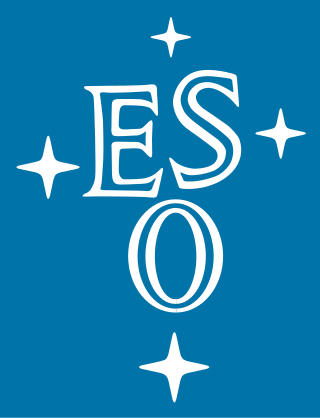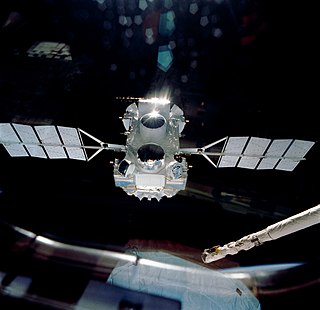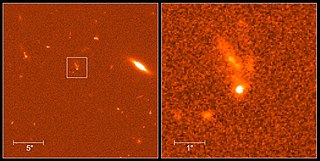
The European Organisation for Astronomical Research in the Southern Hemisphere, commonly referred to as the European Southern Observatory (ESO), is an intergovernmental research organisation made up of 16 member states for ground-based astronomy. Created in 1962, ESO has provided astronomers with state-of-the-art research facilities and access to the southern sky. The organisation employs over 750 staff members and receives annual member state contributions of approximately €162 million. Its observatories are located in northern Chile.

BeppoSAX was an Italian–Dutch satellite for X-ray astronomy which played a crucial role in resolving the origin of gamma-ray bursts (GRBs), the most energetic events known in the universe. It was the first X-ray mission capable of simultaneously observing targets over more than 3 decades of energy, from 0.1 to 300 kiloelectronvolts (keV) with relatively large area, good energy resolution and imaging capabilities. BeppoSAX was a major programme of the Italian Space Agency (ASI) with the participation of the Netherlands Agency for Aerospace Programmes (NIVR). The prime contractor for the space segment was Alenia while Nuova Telespazio led the development of the ground segment. Most of the scientific instruments were developed by the Italian National Research Council (CNR) while the Wide Field Cameras were developed by the Netherlands Institute for Space Research (SRON) and the LECS was developed by the astrophysics division of the European Space Agency's ESTEC facility.

The Compton Gamma Ray Observatory (CGRO) was a space observatory detecting photons with energies from 20 keV to 30 GeV, in Earth orbit from 1991 to 2000. The observatory featured four main telescopes in one spacecraft, covering X-rays and gamma rays, including various specialized sub-instruments and detectors. Following 14 years of effort, the observatory was launched from Space Shuttle Atlantis during STS-37 on April 5, 1991, and operated until its deorbit on June 4, 2000. It was deployed in low Earth orbit at 450 km (280 mi) to avoid the Van Allen radiation belt. It was the heaviest astrophysical payload ever flown at that time at 17,000 kilograms (37,000 lb).

A robotic telescope is an astronomical telescope and detector system that makes observations without the intervention of a human. In astronomical disciplines, a telescope qualifies as robotic if it makes those observations without being operated by a human, even if a human has to initiate the observations at the beginning of the night or end them in the morning. It may have software agents using artificial intelligence that assist in various ways such as automatic scheduling. A robotic telescope is distinct from a remote telescope, though an instrument can be both robotic and remote.

La Silla Observatory is an astronomical observatory in Chile with three telescopes built and operated by the European Southern Observatory (ESO). Several other telescopes are located at the site and are partly maintained by ESO. The observatory is one of the largest in the Southern Hemisphere and was the first in Chile to be used by ESO.

Neil Gehrels Swift Observatory, previously called the Swift Gamma-Ray Burst Explorer, is a NASA three-telescope space observatory for studying gamma-ray bursts (GRBs) and monitoring the afterglow in X-ray, and UV/Visible light at the location of a burst. It was launched on 20 November 2004, aboard a Delta II launch vehicle. Headed by principal investigator Neil Gehrels until his death in February 2017, the mission was developed in a joint partnership between Goddard Space Flight Center (GSFC) and an international consortium from the United States, United Kingdom, and Italy. The mission is operated by Pennsylvania State University as part of NASA's Medium Explorer program (MIDEX).

BOOTES is a Global Network of Robotic Astronomical Observatories with seven sites located in Spain, New Zealand, China, Mexico, South Africa and Chile. While the BOOTES-1 station in Spain is devoted to wide-field astronomy, the additional stations include a similar setup : the 0.6m diameter robotic telescope, the EMCCD camera at the Cassegrain focus and the u'g'r'i'ZY filterset, which makes the BOOTES Network a unique resource for combining the data from all the instruments worldwide.
The InterPlanetary Network (IPN) is a group of spacecraft equipped with gamma ray burst (GRB) detectors. By timing the arrival of a burst at several spacecraft, its precise location can be found. The precision for determining the direction of a GRB in the sky is improved by increasing the spacing of the detectors, and also by more accurate timing of the reception. Typical spacecraft baselines of about one AU and time resolutions of tens of milliseconds can determine a burst location within several arcminutes, allowing follow-up observations with other telescopes.

PROMPT, an acronym for Panchromatic Robotic Optical Monitoring and Polarimetry Telescopes, is being built by the University of North Carolina at Chapel Hill at Cerro Tololo Inter-American Observatory (CTIO) in Chile. PROMPT's primary objective is rapid and simultaneous multiwavelength observations of gamma-ray burst afterglows, some when they are only tens of seconds old. In addition to measuring redshifts by dropout, and early-time SFDs and extinction curves of sufficiently bright afterglows in unprecedented detail, PROMPT will facilitate quick response observations at larger observatories such as the UNC-led 4.1-m SOAR Telescope. PROMPT will also serve as a platform for undergraduate and high school education throughout the State of North Carolina.

High Energy Transient Explorer 2 was a NASA astronomical satellite with international participation. The satellite bus for the first HETE-1 was designed and built by AeroAstro, Inc. of Herndon, Virginia and was lost during launch on 4 November 1996; the replacement satellite, HETE-2 was built by Massachusetts Institute of Technology (MIT) based on the original HETE design.

GRB 970508 was a gamma-ray burst (GRB) detected on May 8, 1997, at 21:42 UTC; it is historically important as the second GRB with a detected afterglow at other wavelengths, the first to have a direct redshift measurement of the afterglow, and the first to be detected at radio wavelengths.

GRB 090423 was a gamma-ray burst (GRB) detected by the Swift Gamma-Ray Burst Mission on April 23, 2009 at 07:55:19 UTC whose afterglow was detected in the infrared and enabled astronomers to determine that its redshift is z = 8.2, which makes it one of the most distant objects detected to date with a spectroscopic redshift.

GRB 990123 is a gamma-ray burst which was detected on January 23, 1999. It was the first GRB for which a simultaneous optical flash was detected. Astronomers first managed to obtain a visible-light image of a GRB as it occurred on January 23, 1999, using the ROTSE-I telescope in Los Alamos, New Mexico. The ROTSE-I was operated by a team under Dr. Carl W. Akerlof of the University of Michigan and included members from Los Alamos National Laboratory and Lawrence Livermore National Laboratory. The robotic telescope was fully automated, responding to signals from NASA's BATSE instrument aboard the Compton Gamma Ray Observatory within seconds, without human intervention. In the dark hours of the morning of January 23, 1999, the Compton satellite recorded a gamma-ray burst that lasted for about a minute and a half. There was a peak of gamma and X-ray emission 25 seconds after the event was first detected, followed by a somewhat smaller peak 40 seconds after the beginning of the event. The emission then fizzled out in a series of small peaks over the next 50 seconds, and eight minutes after the event had faded to a hundredth of its maximum brightness. The burst was so strong that it ranked in the top 2% of all bursts detected.
The Robotic Optical Transient Search Experiment (ROTSE) is a multi-telescope experiment designed to observe the optical afterglow of gamma-ray bursts. The experiment currently consists of four telescopes located in Australia, Namibia, Turkey, and at the McDonald Observatory near Fort Davis, Texas.

The Rapid Eye Mount telescope (REM) is a fully automatic, 60 cm aperture telescope located at ESO's La Silla Observatory at 2,400 metres altitude on the edge of the Atacama Desert in Chile. The telescope's aim is to catch the afterglows of gamma-ray bursts (GRBs). REM is triggered by a signal from a high-energy satellite such as Swift and rapidly points to the detected location in the sky. It is operated for the Italian National Institute for Astrophysics since 2002.
The Livermore Optical Transient Imaging System, or LOTIS, is an automated telescope designed to slew very rapidly to the location of gamma-ray bursts (GRBs), to enable the simultaneous measurement of optical counterparts. Since GRBs can occur anywhere in the sky, are often poorly localized, and fade very quickly, this implies very rapid slewing and a wide field of view. To achieve the needed response time, LOTIS was fully automated and connected via Internet socket to the Gamma-ray Burst Coordinates Network. This network analyzes telemetry from satellite such as HETE-2 and Swift Gamma-Ray Burst Mission and delivers GRB coordinate information in real-time. The optics were built from 4 commercial tele-photo lenses of 11 cm aperture, with custom 2048 X 2048 CCD cameras, and could view a 17.6 X 17.6 degree field.

TAROT is a project of the European Southern Observatory (ESO) aimed at rapidly reacting to particular data from other astronomical surveying facilities to monitor for and registering fast changing astronomical objects and phenomena. The target of this particular project is so-called gamma-ray bursts (GRB).
The Space Variable Objects Monitor (SVOM) is a planned small X-ray telescope satellite under development by China National Space Administration (CNSA), Chinese Academy of Sciences (CAS) and the French Space Agency (CNES), to be launched at the end of 2023.

The Ultra-Fast Flash Observatory (UFFO) Pathfinder is a space observatory measuring prompt emission of gamma-ray bursts (GRB) both in optical/UV and in X-ray range down to sub-second timescales for the first time. Instead of turning the whole satellite towards GRB location like the Swift Gamma-Ray Burst Mission, UFFO employs a slewing mirror telescope approach – the optical path of the telescope is changed by rotation of motorized mirror within ~1 second after burst was detected.














